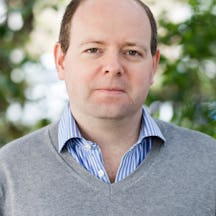During the final months of World War II a young American surgeon saved the lives of well over 100 shrapnel-injured soldiers in a Gloucestershire field hospital. So remarkable was his expertise in removing projectiles from patients’ hearts that leading surgeons from the UK flocked to observe him at work.
The problem of the punctured heart
Words by Thomas Morrisartwork by Emily Evansaverage reading time 6 minutes
- Serial

The modern discipline of heart surgery had an unlikely birthplace. Its genesis did not occur in one of the great hospitals of Berlin, London or New York, but in a tiny hut built from breeze blocks and corrugated iron in a field in rural Gloucestershire.
Such was the makeshift operating theatre of Dwight Harken, a young surgeon from Iowa who arrived in England with the US military in 1944. At the age of 34 he was appointed to run a sprawling field hospital specialising in chest injuries, which had been set up in preparation for D-Day.
During the last year of the war Harken removed bullets and shell fragments from the chests of 134 soldiers. Fifty-six of these casualties had projectiles lodged inside their hearts, but the most extraordinary fact is that every single one of Harken’s patients survived.
The challenging case of Leroy Rohrbach
One of Harken’s trickiest cases was Leroy Rohrbach, an infantry sergeant injured during the Battle of Normandy in July 1944. An exploding shell had sent a piece of shrapnel deep into his chest, and the wounded man was airlifted to England for treatment.
Twice Harken had operated on the young soldier, and twice the metal fragment had slipped from his grasp just as he was about to remove it from inside the heart. He was reluctant to try again, since Rohrbach’s life was not in any imminent danger, and a further operation might be more dangerous than doing nothing.
But Rohrbach begged him to persevere. He was tormented by thoughts of the rogue shard of metal loose in his bloodstream, and lived in terror of what it might do to him. So, on 19 February 1945, Harken made a third and final attempt.
Although his operating theatre was little more than a prefabricated hut, it was filled with state-of-the-art equipment and the latest drugs. On this occasion it was also packed with bodies, since a delegation of top British surgeons had come to watch the young American operate. The anaesthetists had been at work before Harken even arrived on the scene: Rohrbach was already lying unconscious on the table, his chest stripped to reveal the scars from his two previous operations.
Harken picked up a scalpel and reopened one of these earlier incisions, making a neat opening under Rohrbach’s left nipple. He then widened the aperture, using a pair of retractors to pull two adjacent ribs apart, and exposed the heart by cutting through the pericardium, the tough fibrous sac surrounding it.
Rohrbach’s heart was now in plain view, scarred by its previous encounters with the scalpel, its muscle contracting irregularly and unnaturally fast. Harken knew that he needed to be quick, since prolonged handling might cause it to stop entirely.

A surviving Quonset hut – a galvanised-steel structure based on the Nissen hut design – at the site of the field hospital where Dwight Harken operated.
Three minutes to save the patient
Gently probing the organ with his forefinger, Harken could feel a small, hard object through its wall. This was the shell fragment, and he held it in place with one hand while preparing to extract it with the other. He inserted two rows of stitches on either side – known as ‘control sutures’, these lengths of catgut could be pulled together quickly to stop any bleeding.
After checking that his assistants were ready, Harken made a small incision in the muscular wall of the heart and made a grab for the elusive piece of shrapnel with a pair of forceps. There was a brief moment of calm, and then the metal fragment, propelled by the extraordinary pressure within the heart, leapt out of the incision with a noise that Harken likened to the pop of a champagne cork.
There was a sudden torrent of blood. The assisting surgeon pulled the control sutures taut, but the bleeding continued. Harken used his finger to plug the wound, and quickly stitched around it. The haemorrhage had finally been arrested, but when Harken tried to remove his finger he found that he had managed to sew his glove to the cardiac surface. Once a colleague had cut him loose, the difficult part of the operation was finally complete. Despite all the drama, it had taken just three minutes.
The pioneer of successful cardiac surgery
This early cardiac operation was one of the first to be documented on film. The footage contains a tantalisingly brief shot of Leroy Rohrbach recovering afterwards, sitting up in bed and grinning at the camera as a gravelly voiceover intones solemnly that “the patient is comfortable”. The sergeant made a complete recovery and was soon able to return to his home in Ohio.
Dwight Harken was far from being the first surgeon to operate on a beating human heart. That honour belongs to the German Ludwig Rehn, who in 1896 saved the life of a young man who had been stabbed in the chest by stitching a small wound in his heart muscle. Rehn’s operation broke a long-standing surgical taboo: until he proved otherwise, many experts believed that the heart was so uniquely vulnerable that even attempting to operate on it would have fatal consequences.
There was a brief moment of calm, and then the metal fragment, propelled by the extraordinary pressure within the heart, leapt out of the incision.
So why do many cardiac surgeons regard Harken, rather than Rehn, as the real founder of their profession?
The answer is that Harken excelled his predecessors both in quality and quantity. In the preceding half-century, a small number of surgeons worldwide had operated on the heart, and a handful of them had done so more than once. Such operations were usually undertaken in conditions of dire necessity, and around half of their patients died.
Harken was the first to demonstrate that it was possible for a single surgeon to operate on more than 50 patients without experiencing a single death. In his hands, cardiac surgery started to look as if it could be both safe and routine.
Heart surgery in progress.
During the 18 months that Harken spent in Gloucestershire, many of Britain’s leading surgeons made the pilgrimage to his tiny operating theatre to watch him at work. When he returned to the United States in 1945, it was not long before his colleagues there also knew about the astonishing feats he had achieved.
His success stimulated enormous interest in the potential benefits of cardiac surgery. Specialists realised that it might be possible not just to repair wounds, but to correct congenital deformities and reverse the effects of disease. From modest beginnings in this small hut in the Cotswolds a new speciality was born.
About the contributors
Thomas Morris
Thomas Morris is author of ‘The Matter of the Heart’ and more recently ‘The Mystery of the Exploding Teeth and Other Curiosities from the History of Medicine’. He has worked as a radio producer for the BBC on such programmes as ‘Front Row’, ‘Open Book’ and Melvyn Bragg’s ‘In Our Time’, and his journalism has appeared in publications including the Lancet and the Times.
Emily Evans
Emily Evans is a medical illustrator and anatomist. After her role as a senior demonstrator of anatomy at Cambridge University, alongside her career illustrating medical and surgical books for over a decade, she now writes and publishes books about anatomy and art, such as ‘Anatomy in Black’, while running her brand, Anatomy Boutique.


